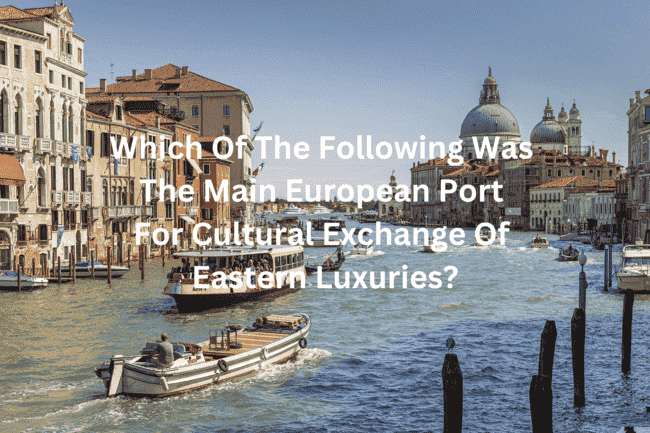Which of the following was the main European port for cultural exchange of Eastern luxuries?
a. Vienna
b. Venice
c. Paris
Answer: The main European port for the cultural exchange of Eastern luxuries was Venice.
Why was Venice, Italy the main European port for the cultural exchange of Easter luxuries?
Venice became the main European port for the cultural exchange of Eastern luxuries due to several key factors that are described below:
1. Strategic Location
Venice’s location on the northeastern coast of Italy, on the Adriatic Sea, gave it a unique advantage. It was perfectly situated between Western Europe and the Eastern Mediterranean, allowing it to serve as a critical gateway for trade with the Byzantine Empire, the Islamic world, and even as far as Asia.
2. Dominance of Trade Routes
At the end of the 13th century, Venice had developed a powerful merchant fleet and established control over key Mediterranean trade routes. This allowed Venetian merchants to travel to the Middle East and beyond, bringing back luxurious goods like silk, spices, and precious stones from places such as India, China, and the Arab world.
- Byzantine connections: Venice maintained a strong relationship with the Byzantine Empire, which controlled trade routes between Europe and the East.
- Muslim trade networks: Venice established close ties with the Muslim world, especially Egypt and the Ottoman Empire, ensuring access to Eastern goods.
3. Monopoly on Eastern Luxuries
Venice held monopolies on the import of many Eastern luxury goods, including spices, silk, and other precious commodities. They acted as intermediaries between the Eastern world and Europe, making Venetian merchants some of the richest and most influential traders in Europe. By controlling supply, they could set high prices, making Venice enormously wealthy.
4. Fourth Crusade and Political Influence
Venice’s influence grew significantly after the Fourth Crusade (1204), when the city played a key role in diverting the crusaders to sack Constantinople. This gave Venice control over important ports in the Eastern Mediterranean, including parts of the Byzantine Empire, further solidifying its dominance over trade routes.
After the fall of Constantinople, Venice continued to thrive by negotiating trade agreements with the new rulers of the region, including the Ottoman Empire.
5. Maritime Expertise
Venice was a leading force in shipbuilding and navigation, which enabled its merchants to navigate the Mediterranean and beyond efficiently. The Arsenale, Venice’s state-run shipyard, was one of the most advanced shipbuilding facilities in Europe, capable of producing a fleet of ships quickly and ensuring Venice’s maritime dominance.
6. Financial Innovation
Venice pioneered early financial practices such as the use of bills of exchange, public banks, and maritime insurance. This allowed Venetian merchants to finance long-distance trade more effectively and manage the risks involved in importing high-value luxury goods from the East.
7. Cultural Openness and Diplomacy
Venice was not only a commercial center but also a cultural hub where East met West. Its diplomatic relations with both Christian and Muslim powers allowed for a more fluid exchange of goods, ideas, and cultural influences. Venetian traders and diplomats often served as cultural intermediaries, bringing knowledge, art, and luxury items from the East to Europe.
8. Venice’s Republican Government
Venice’s stable and prosperous republican government provided a secure and supportive environment for trade. The city’s ruling elite, many of whom were wealthy merchants, understood the importance of maintaining political neutrality and strong diplomatic relations, which allowed Venetian traders to operate in multiple territories, both Christian and Muslim.
9. Demand for Luxury Goods in Europe
The growing demand in Europe for luxury goods like silk, spices, perfumes, and exotic artworks from the East fueled Venice’s rise. European nobility and the wealthy class sought these rare and valuable items, and Venice became the primary supplier due to its extensive trade networks.
10. Cultural Exchange
Beyond material goods, Venice was a center for cultural exchange. The art, architecture, and science of Venice were heavily influenced by Eastern styles and ideas. Venetian artists, such as Carpaccio and Bellini, incorporated Eastern elements into their work, while Venetian architects adopted styles seen in Byzantine and Islamic architecture.
Conclusion
Venice’s rise as the main European port for the exchange of Eastern luxuries was driven by its geographic position, control over vital trade routes, advanced maritime capabilities, and strong diplomatic ties with Eastern powers. These factors allowed Venice to dominate the luxury goods trade for centuries and significantly influence the culture and economy of Europe during the medieval and Renaissance periods.

